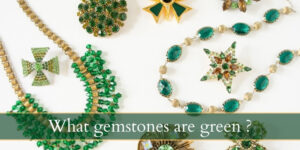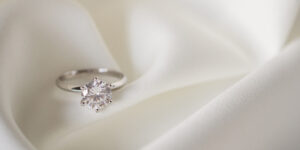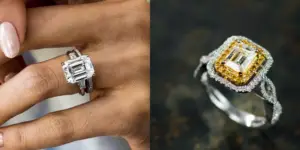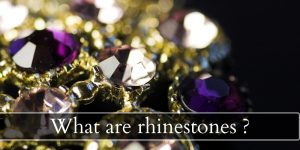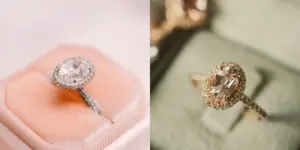When you’re choosing the perfect set of pearls for a necklace, earrings, or even just one pearl to set as a centerpiece on a ring, you’re going to have a lot of options. Pearls, for all their rarity, come in many shapes and sizes and colors, and there are two main kinds you can buy: saltwater or freshwater.
Both pearl types refer to the way the pearls form, the medium they form in, and often the kind of oyster they originate from. The following comparison addresses cultured freshwater and saltwater pearls, since cultured (farmed) pearls are the most common pearls on the market.
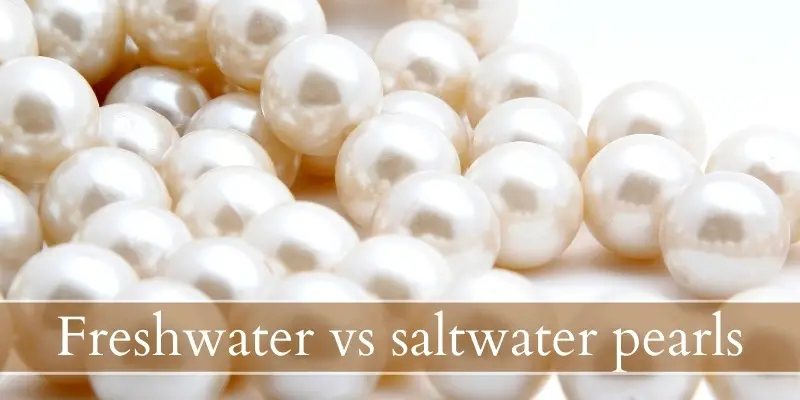
Freshwater vs saltwater pearls
Freshwater pearls tend to have more nacre per pearl, and in thicker layers. Saltwater pearls, despite having thinner and less nacre, have a better luster and more color variation than freshwater, without being dyed.
Because saltwater oysters tend to only produce one pearl per oyster, and it takes longer to form, these pearls are often more expensive than the freshwater cousins. There is also a distinct difference in luster and light return, with freshwater pearls giving a softer, more blurred light reflection, while saltwater pearls have a sharper, high-shine finish.
Both freshwater and saltwater pearls can be cultured, and that is what this post will be discussing today. Many of the following points can be applied to natural saltwater and freshwater pearls, but they are much rarer.
1. Freshwater pearls tend to have more nacre, but of lower quality
A key difference between freshwater and saltwater pearls is the amount of nacre they have on them. A pearl is formed when an intruding object – parasite, piece of shell, or tissue – somehow enters the oyster and the oyster cannot expel it. To protect itself, the oyster deposits layers upon layers of nacre (mother of pearl) onto the intruder, thus forming a pearl.
The more layers of nacre, the bigger the pearl, and the better the shine and color. However due to the difference in species between freshwater and saltwater oysters, freshwater pearls tend to have more nacre on them, because of thicker layers and because their nucleus is often much, much smaller.
So the overall nacre percentage is much higher than in saltwater pearls. However the quality is a bit lower, in that the luster is a bit duller and the colors are not as impressive as a saltwater pearl. A freshwater pearl has a blurry shine with soft edges, and if that’s the look you’re going for then these are the pearls for you.
Saltwater pearls have a thinner layer of nacre, but it tends to be of better quality. Higher luster and better shine, with more color saturation and color variation. For example the famous Akoya pearls are saltwater pearls, and they’re always remarkably round, high-shine, and come in the classic white.
Read also: Pearl VS Diamond
2. Saltwater pearls are seeded with shell, freshwater with mantle tissue
In the case of cultured pearls, there is a difference between the nucleus used for each pearl type. All cultured pearls are manually seeded via precision surgery. So for saltwater pearls, a tiny rounded piece of shell from a sacrificed oyster is inserted into the oyster. This small bead is often around 0.5 mm in diameter, and most pearls are between 8-15 mm in diameter when fully formed.
For freshwater pearls, the insert is a tiny (0.1 mm) piece of mantle tissue from a sacrificed oyster. This not only means that the nucleus is smaller, it also means it will disintegrate in time, leaving the pearl to be nearly 100% nacre.
3. Freshwater pearls can usually produce more than one pearl per oyster
Despite being almost completely nacre, freshwater pearls are often much cheaper than saltwater pearls. This is in part due to the better quality nacre on saltwater pearls, but also due to the higher yield of freshwater oysters. These can be seeded with multiple implants, thus making several pearls per oyster, while saltwater oysters fare better if carrying a single pearl.
So the total production volume of freshwater pearls far exceeds that of saltwater, thus bringing down their price, even if their tend to be larger and have more nacre than saltwater pearls.
4. Saltwater pearls tend to be more expensive than freshwater
Because saltwater pearls are to precious, they are more expensive than freshwater. Saltwater pearls can only be made one per oyster, and they’re often smaller than the freshwater ones. They have higher luster and better color, without having to be treated as often as freshwater pearls.
For example an 18 inch pearl necklace, with 7.0-7.5 mm white Akoya pearls of the highest quality goes for $910. These are saltwater pearls, cultured.
Another pearl necklace, also 18 inches long, with 7.5-8.0 mm white cultured freshwater pearls of the highest quality goes for $480. These are online prices, and you will always find a better deal online than in brick and mortar stores.
Neither of those links are sponsored, they are there just for example’s sake. You can see the price difference between the two is steep.
5. Freshwater pearls are often dyed a specific color
If you’re looking for a very specific or exotic pearl color, you may want to look for freshwater pearls. While they don’t form in the brightest or most varied of colors, they are often dyed. Which means you’ll have an easier time finding a rare color like dark green, or eggplant, or burgundy with freshwater pearls.
Saltwater pearls do form in more extravagant colors by nature, but are harder to find, since they’re often left in their natural color. Say you want to have a pair of eggplant pearls. A pair of these would cost double if saltwater than freshwater, and possibly even more if you want this specific color as it’s not as common as white or cream.

I’m the main author for jewelrymaterialguide.com. I started this site after we did tons of research before our wedding and noticed that there is information about rings, jewelry, and so on that is really hard to find on the internet.


